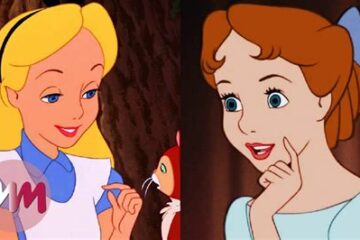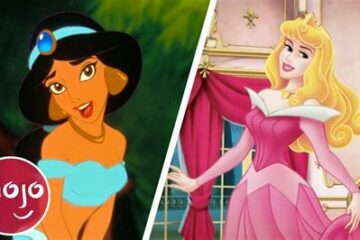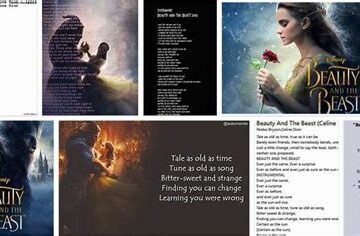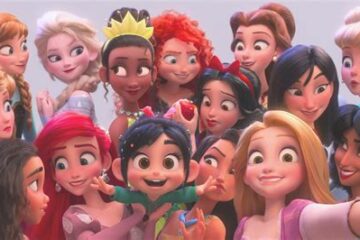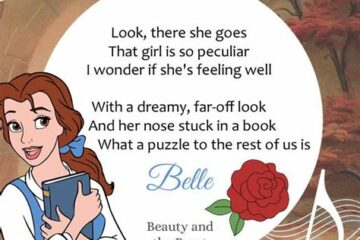The Impact of Beauty and the Beast Cartoon on Pop Culture

The Impact of Beauty and the Beast Cartoon on Pop Culture
Introduction: Beauty and the Beast’s Cultural Influence
Beauty and the Beast, the beloved Disney animated film released in 1991, has left an indelible mark on popular culture. From its breathtaking animation and memorable characters to its enchanting music and timeless story, this tale as old as time continues to captivate audiences of all ages. In this blog post, we will explore the incredible cultural influence of Beauty and the Beast, examining how it revolutionized animation, contributed to the fairy tale renaissance, lifted the stigma surrounding animated films, and left a lasting legacy in the world of pop culture. Join us as we delve into the magic and significance of Beauty and the Beast.
Introduction: Beauty and the Beast’s Cultural Influence
Beauty and the Beast, the timeless tale of love and transformation, has captured the hearts of audiences around the world since its release in 1991. This enchanting Disney film, based on the French fairy tale, has had a significant cultural influence, touching the lives of both young and old. In this blog post, we will delve into the magical world of Beauty and the Beast and explore the ways in which it has become a cultural phenomenon.
One of the key reasons behind Beauty and the Beast’s cultural influence is its ability to transcend generations. From children who eagerly sing along to the catchy tunes, to adults who appreciate the deeper themes of acceptance and self-love, this film has resonated with audiences of all ages. Its relatability lies in its portrayal of characters who struggle with their own imperfections and learn the importance of looking beyond appearances.
Furthermore, Beauty and the Beast has become a cultural icon through its memorable characters and captivating storytelling. The film introduced us to Belle, the strong-willed and independent heroine who yearns for adventure beyond the confines of her small village. With her intelligence and bravery, Belle has inspired countless young girls to embrace their individuality and pursue their dreams.
Revolutionizing Animation: Beauty and the Beast’s Technological Breakthroughs
Beauty and the Beast, the iconic Disney animated film, not only captured the hearts of millions with its enchanting story and memorable characters, but it also revolutionized the world of animation through its groundbreaking technological advancements. This animated masterpiece, released in 1991, marked a turning point in the history of animation, pushing the boundaries of what was thought possible and laying the foundation for future innovations in the industry.
One of the key technological breakthroughs introduced in Beauty and the Beast was the use of Computer Generated Imagery (CGI) seamlessly blended with traditional hand-drawn animation. The ballroom dance sequence between Belle and the Beast is a prime example of this remarkable fusion. By employing CGI, animators were able to create a three-dimensional environment, giving depth and realism to the scene. This breakthrough not only enhanced the visual aesthetics of the film but also set a new standard for animation quality.
Another significant technological achievement in Beauty and the Beast was the implementation of the CAPS (Computer Animation Production System) technology. CAPS allowed for the digitalization of the animation process, enabling artists to colorize and manipulate the hand-drawn frames using computer software. This innovation resulted in more vibrant and visually stunning animations, leading to a more immersive viewing experience for audiences.
Fairy Tale Renaissance: Beauty and the Beast’s Contribution to the Genre
In the world of animation, there are certain movies that have left a lasting impact and have become iconic in their own right. One such film that stands out is Disney’s “Beauty and the Beast.” Released in 1991, this animated masterpiece not only captured the hearts of millions around the world but also contributed significantly to the fairy tale renaissance in the genre.
The release of “Beauty and the Beast” marked a turning point in the world of animated fairy tales. It took the traditional fairy tale formula and gave it a modern twist, making it appeal to a wider audience. The film incorporated elements of romance, magic, and adventure, making it relatable to both children and adults alike. This unique approach revolutionized the way fairy tales were portrayed on the big screen.
One of the key contributions of “Beauty and the Beast” to the fairy tale genre was the portrayal of strong female characters. The film introduced Belle, a smart, independent, and courageous young woman who defied the traditional damsel in distress stereotype. Belle’s character became an inspiration for many young girls, showing them that they can be the hero of their own stories.
Not only did “Beauty and the Beast” break the stereotypes surrounding female characters, but it also brought a refreshing change in the portrayal of the “beast.” Traditionally, beasts were depicted as monstrous and evil creatures. However, the film portrayed the beast as a complex character with a vulnerable side, capable of transformation through love and compassion. This nuanced depiction added depth to the story and challenged the audience’s perception of beauty and the notion of inner beauty.
In addition to its groundbreaking story and character development, “Beauty and the Beast” also showcased technological breakthroughs in the field of animation. With the use of computer-generated imagery (CGI), the film brought the enchanting castle and its magical inhabitants to life. This combination of traditional hand-drawn animation and CGI opened new doors for animated storytelling, setting new standards for the genre.
As the years went by, the impact of “Beauty and the Beast” on the fairy tale genre continued to resonate. The film inspired countless adaptations and retellings of the beloved story, both in animated and live-action formats. Its success paved the way for other classic fairy tales to be brought to life on the big screen, giving rise to a fairy tale renaissance.
In conclusion, “Beauty and the Beast” made a significant contribution to the fairy tale genre, revolutionizing the way these stories were told and perceived. Through its strong female characters, portrayal of the beast, and technological breakthroughs, the film left an indelible mark on animation history. Its enduring legacy can still be felt in the countless adaptations and retellings that continue to captivate audiences to this day.
Lifting the Animation Stigma: Beauty and the Beast’s Critical Acclaim
In today’s blog post, we will be discussing the critical acclaim received by the iconic film, Beauty and the Beast, and how it played a significant role in lifting the stigma surrounding animation as a serious art form. Throughout history, animation has often been dismissed as a genre exclusively for children, but Beauty and the Beast challenged this notion and showcased the incredible artistic and storytelling capabilities of the medium.
The film, released by Disney in 1991, was a game-changer in the world of animation. It captivated audiences with its stunning visuals, memorable characters, and heartfelt story. Beauty and the Beast became the first animated film to be nominated for the prestigious Academy Award for Best Picture, proving that animation can be just as deserving of recognition as any live-action film.
One of the reasons behind Beauty and the Beast’s critical acclaim was its ability to resonate with audiences of all ages. The film tackled important themes such as love, acceptance, and the true nature of beauty, which struck a chord with both children and adults. The timeless tale of love overcoming appearances was beautifully portrayed through the enchanting animation and the powerful performances of the voice actors.
- Beauty and the Beast challenged the notion that animation was solely for children.
- The film was the first animated feature to be nominated for Best Picture at the Academy Awards.
- Beauty and the Beast resonated with audiences of all ages due to its powerful themes.
| Key Points | Description |
|---|---|
| Challenge to Perception | Beauty and the Beast challenged the perception that animation was only for children, showcasing its broad appeal. |
| Award Recognition | The film’s nomination for Best Picture at the Academy Awards marked a significant milestone for animation in the industry. |
| Universal Themes | Through its exploration of love and acceptance, Beauty and the Beast connected with people of all ages, transcending the boundaries of traditional animated storytelling. |
Beauty and the Beast’s critical acclaim propelled the animation industry forward, elevating it to a level of respect and admiration previously unseen. It paved the way for future animated films to be taken more seriously as valid and valuable works of art. The film’s success also opened doors for other animated features to explore complex themes and attract wider audiences.
The legacy of Beauty and the Beast’s critical acclaim continues to endure today. It remains a beloved classic, celebrated for its groundbreaking achievements in animation and its ability to touch the hearts of viewers around the world. The film’s impact can be seen in the subsequent success of other animated films that have received critical acclaim and recognition, demonstrating the lasting influence of Beauty and the Beast on the animation industry as a whole.
Legacy Endures: Beauty and the Beast’s Lasting Pop Culture Impact
The legacy of Disney’s Beauty and the Beast continues to endure, with a lasting impact on pop culture. Released in 1991, the film quickly became a beloved classic, captivating audiences of all ages. Its popularity has only grown over the years, as it remains a cornerstone of Disney’s animated filmography. This article will explore the different ways in which Beauty and the Beast has left a significant mark on popular culture, cementing its status as an enduring icon.
List of Beauty and the Beast’s Lasting Pop Culture Impact:
- Musical Influence: The film’s soundtrack, composed by Alan Menken, has become iconic. The songs, such as “Beauty and the Beast” and “Be Our Guest,” resonate with audiences even today. The soundtrack’s success led to the creation of a hit Broadway musical and several successful international adaptations.
- Merchandising Phenomenon: Beauty and the Beast’s characters, especially Belle, have become mainstays in Disney merchandise. From toys and clothing to home décor items, the film’s characters continue to be popular choices for consumers.
- Cultural Impact: Beauty and the Beast challenged traditional gender roles and depicted a strong, independent female protagonist in Belle. The film’s portrayal of Belle as an intelligent and resourceful young woman resonated with audiences and set a new standard for Disney princesses.
Table showcasing Beauty and the Beast’s Lasting Pop Culture Impact:
| Impact | Description |
|---|---|
| Musical Influence | The film’s soundtrack became a hit, leading to a successful Broadway musical and international adaptations. |
| Merchandising Phenomenon | Characters from Beauty and the Beast continue to be popular choices for Disney merchandise. |
| Cultural Impact | The film challenged gender roles and presented a strong, independent female protagonist. |
Beauty and the Beast’s lasting pop culture impact can be felt in various aspects of society. Its memorable music, timeless characters, and empowering message have solidified its place in the hearts of millions. Whether through the continued success of the musical adaptation or the enduring popularity of its merchandise, the legacy of Beauty and the Beast will continue to live on for generations to come.
Frequently Asked Questions
How did Beauty and the Beast revolutionize animation?
Beauty and the Beast introduced breakthroughs in animation technology, including the innovative use of computer-generated imagery (CGI) integrated with traditional hand-drawn animation.
What was the cultural influence of Beauty and the Beast?
Beauty and the Beast’s cultural influence can be seen in its impact on shaping perceptions of beauty, challenging gender roles, and promoting the importance of inner qualities.
How did Beauty and the Beast contribute to the fairy tale genre?
Beauty and the Beast revitalized the fairy tale genre by presenting a more complex and empowering portrayal of the female protagonist, breaking away from traditional damsel-in-distress narratives.
How did Beauty and the Beast challenge the animation stigma?
Beauty and the Beast’s critical acclaim and recognition at the 64th Academy Awards demonstrated that animation could be a legitimate form of artistic expression, effectively lifting the stigma surrounding animated films.
What is the lasting impact and legacy of Beauty and the Beast?
Beauty and the Beast’s legacy endures through its continued popularity, cultural references, and its influence in shaping subsequent Disney animated films and empowering heroines in storytelling.
How did Beauty and the Beast contribute to changing gender roles in animated films?
Beauty and the Beast played a vital role in advocating for empowered heroines by presenting Belle as an intelligent, independent, and strong female character, challenging traditional gender roles.
What was the international success of Beauty and the Beast?
Beauty and the Beast became an international phenomenon, grossing over $425 million worldwide upon its original release and captivating audiences across different cultures and languages.
Top 10 Disney Characters You Didn’t Know About
December 30, 2024A Deep Dive Into Disney Princesses And Their Stories
December 29, 2024The Meaning Behind Beauty And Beast Lyrics
December 29, 2024Why Beauty And The Beast Is A Timeless Disney Classic
December 29, 2024The Role Of Disney Princesses In Modern Culture
December 29, 2024Exploring The Themes In Beauty And The Beast Lyrics
December 28, 2024
Leave a reply Cancel reply
Recommended
-
Be Our Guest Lyrics From Beauty And The Beast
August 26, 2023 -
Beauty And The Beast Song Gaston Lyrics
August 25, 2023 -
Beauty and the Beast Reprise Lyrics
November 16, 2021

